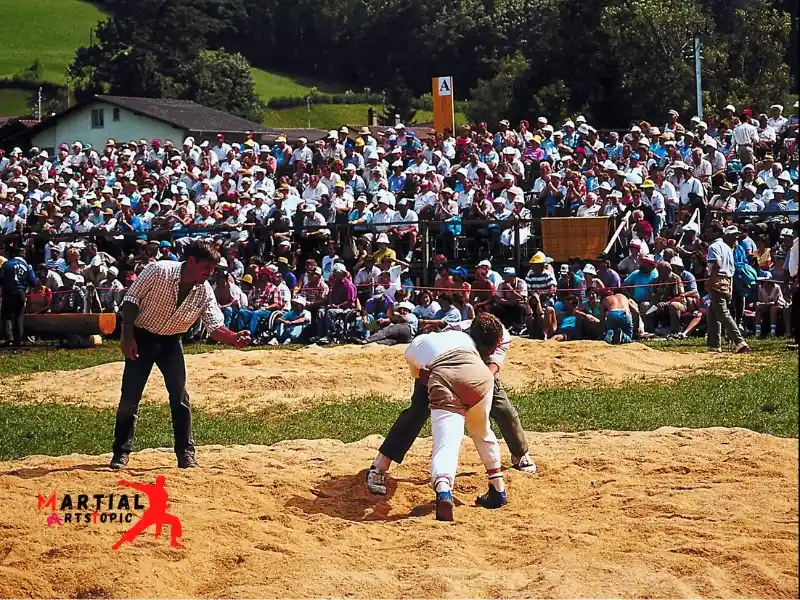
Unveiling the Power of Schwingen: The Art of Swiss Wrestling
Unveiling the Power of Schwingen: The Art of Swiss Wrestling welcome to our comprehensive guide on Schwingen, the traditional Swiss wrestling style that has been captivating audiences for centuries. The fascinating world of Schwingen, exploring its history, techniques, and the philosophy behind this ancient martial art.
The History of Schwingen
Schwingen, also known as Swiss wrestling, has deep roots in Swiss culture and tradition. It dates back to the 13th century when it was practiced by shepherds in the Swiss Alps as a way to stay fit and pass time during long periods of isolation. Over time, it developed into a popular sport with organized competitions and a dedicated following.
The Techniques of Schwingen
One of the most intriguing aspects of Schwingen is its unique set of techniques that sets it apart from other forms of wrestling. The primary objective in Schwingen is to pin your opponent’s shoulders to the ground while maintaining control and balance. This requires a combination of strength, agility, and strategic thinking.
Key techniques in Schwingen include “Hüfter” (hip throw), “Kurz” (short hold), and “Übersprung” (overthrow). These maneuvers require precise timing and execution, making Schwingen both physically demanding and mentally stimulating.
The Philosophy of Schwingen
Beyond its physical aspects, Schwingen embodies a rich philosophy centered on respect, discipline, and fair play. Practitioners of Schwingen are encouraged to cultivate humility and honor both on and off the wrestling mat. This ethos has contributed to the enduring appeal of Schwingen as more than just a sport but as a way of life for many enthusiasts.
Unveiling the Power within You
Whether you are an aspiring athlete or simply someone intrigued by martial arts traditions, exploring the world of Schwingen can be a transformative experience. Its emphasis on mental fortitude and physical prowess offers valuable lessons that extend far beyond the confines of the wrestling arena.
Understanding Schwingen
What is Schwingen? Schwingen, also known as Swiss wrestling, is a traditional Swiss sport that dates back to the 13th century. This style of wrestling emphasizes the use of holds and throws to gain control over the opponent. Understanding Schwingen involves mastering the techniques of gripping, leverage, and balance to outmaneuver your opponent. The sport is deeply rooted in Swiss culture and continues to be popular in rural areas, where Schwingen festivals and competitions are held. Learning the art of Schwingen requires dedication, discipline, and a deep understanding of both offensive and defensive strategies. As you delve into the world of Schwingen, you’ll discover the rich history and traditions that have shaped this unique martial art.
What is Schwingen?
What is Schwingen? Schwingen, also known as Swiss wrestling, is a traditional style of folk wrestling that has been practiced in Switzerland for centuries. The sport involves two competitors wearing special wrestling breeches that they use to gain leverage over their opponent. The goal is to throw your opponent onto their back and hold them there for a brief moment, similar to techniques used in judo or sumo wrestling. Schwingen requires a combination of strength, agility, and strategy, making it a challenging and exciting martial art to master. If you’re looking to explore a unique and traditional form of wrestling, Schwingen is definitely worth considering.
History and Origins of Schwingen
Schwingen, also known as Swiss wrestling, has a rich history deeply rooted in Swiss culture. The origins of Schwingen can be traced back to the early 13th century, where it was practiced as physical and mental training for Swiss soldiers. Over time, Schwingen developed into a popular folk sport, with organized competitions and events taking place across Switzerland. The traditional attire worn during Schwingen matches, including the iconic wrestling shorts called “breeches,” adds to the unique cultural significance of this martial art. Today, Schwingen continues to thrive as a beloved sport, showcasing the enduring traditions and values of Swiss heritage.
Origins of Schwingen

Schwingen, also known as Swiss wrestling, traces its roots back to the rural regions of Switzerland. It was originally practiced as a way for shepherds to pass the time during long periods of isolation in the mountains. Over time, it developed into a competitive sport with organized events and dedicated practitioners.
The sport’s origins can be traced back to the 13th century when it was used as combat training for soldiers. However, it wasn’t until the 19th century that Schwingen gained widespread popularity as a competitive sport.
Evolution of Schwingen
As interest in Schwingen grew, so did the need for standardized rules and regulations. In 1895, the Eidgenössischer Schwingerverband (Swiss Wrestling Association) was founded to oversee and organize official competitions. Since then, Schwingen has become an integral part of Swiss cultural heritage, with annual tournaments drawing enormous crowds and showcasing top talent from across the country.
The techniques used in Schwingen have also developed over time, with practitioners constantly refining their skills and strategies. The sport’s emphasis on strength, agility, and technique makes it both physically demanding and mentally stimulating for participants.
Why Schwingen Endures
Despite its ancient origins, Schwingen remains popular in modern-day Switzerland. Its deep connection to tradition and heritage has ensured its continued relevance in Swiss society. The sense of camaraderie and sportsmanship displayed by participants further adds to its appeal.
For those looking to understand more about Swiss culture or simply explore an intriguing martial art form, delving into the world of Schwingen can be both educational and entertaining.
Basic Techniques

The basic techniques is essential. One fundamental technique that you’ll come across is the schwingen, which is a versatile and effective move. The schwingen, also known as the hip throw, involves using your hip to throw an opponent off balance and onto the ground. It’s a great technique for self-defense and can be applied in various martial arts disciplines. Learning the schwingen requires focus, practice, and proper form, but once mastered, it can be a valuable addition to your martial arts arsenal. Keep practicing and perfecting your schwingen to enhance your skills and confidence in martial arts!
Now, let’s explore some of the basic techniques of schwingen that every martial artist should be familiar with:
- Grip and Control: A crucial aspect of schwingen is the ability to establish a firm grip and maintain control over your opponent. This involves gripping your opponent’s uniform or body in a way that restricts their movement while allowing you to maintain stability and leverage.
- Throwing Techniques: Schwingen incorporates a variety of throwing techniques that are designed to off-balance and immobilize opponents. These techniques often leverage the opponent’s momentum and body positioning to execute powerful throws.
- Groundwork and Submission Holds: In schwingen, practitioners also learn essential groundwork and submission holds to control opponents on the mat. These techniques involve utilizing leverage and joint manipulation to immobilize an opponent and force them into a submission.
- Footwork and Movement: Effective footwork and movement are essential in schwingen, as they enable practitioners to maintain balance, evade attacks, and set up their own offensive maneuvers.
Advanced Techniques
What is Schwingen, you ask? Schwingen, also known as “the swing” or “the throw,” is a dynamic and versatile technique that originates from traditional martial arts disciplines. It involves using momentum, leverage, and precise body mechanics to unbalance and control your opponent, ultimately leading to a decisive takedown or throw.
The key to mastering Schwingen lies in understanding the principles of timing, positioning, and fluidity of movement. It requires a deep connection between the mind and body, as well as an acute awareness of your opponent’s movements and intentions.
To execute Schwingen effectively, practitioners must develop exceptional footwork, balance, and agility. It’s a technique that demands both physical and mental prowess, making it a challenging yet rewarding skill to hone.
Now, let’s delve into some advanced tips for mastering Schwingen:
- Timing and Anticipation: Mastering Schwingen requires the ability to anticipate your opponent’s movements and capitalize on their vulnerabilities. By honing your sense of timing and developing a keen eye for openings, you can execute Schwingen with precision and efficiency.
- Fluid Body Mechanics: The seamless integration of body movements is crucial in executing Schwingen. Practitioners must focus on maintaining fluidity in their techniques, ensuring that every motion seamlessly transitions into the next, culminating in a powerful and controlled throw.
- Leverage and Momentum: Schwingen is all about utilizing your opponent’s energy and momentum to your advantage. By understanding the principles of leverage and momentum, you can effectively redirect and manipulate your opponent’s force, setting the stage for a successful Schwingen maneuver.
- Counter Techniques: A deep understanding of counter techniques is essential for mastering Schwingen. Being able to adapt and respond to your opponent’s actions with precise and calculated counters enhances your ability to seamlessly integrate Schwingen into your martial arts repertoire.
- Visualization and Mental Focus: Visualization and mental focus play a pivotal role in mastering Schwingen. By visualizing the execution of the technique and maintaining unwavering mental focus, practitioners can enhance their overall performance and execution of Schwingen in real-time scenarios.
Physical Training for Schwingen
Physical training for Schwingen, it’s essential to focus on building strength, agility, and balance. Incorporating exercises that target the muscles used in Schwingen, such as the core, legs, and upper body, can greatly improve performance. Including activities like squats, lunges, and deadlifts can help develop the lower body strength needed for powerful throws and maneuvers. Additionally, incorporating balance exercises like yoga or stability drills can enhance overall stability and control during Schwingen matches. It’s also important to include cardiovascular training to improve endurance, as Schwingen bouts can be physically demanding. By following a well-rounded training regimen that includes these elements, athletes can enhance their physical capabilities and excel in the sport of Schwingen.
Training Tips for Schwingen
- Strength Training: Schwingen requires a great deal of upper body strength, particularly in the arms, shoulders, and back. Incorporate exercises such as pull-ups, deadlifts, and overhead presses into your routine to build the necessary strength for executing powerful throws and holds.
- Core Stability: A strong core is essential for maintaining balance and stability during Schwingen matches. Include exercises like planks, Russian twists, and medicine ball throws to strengthen your core muscles and improve your overall stability on the mat.
- Agility Drills: Schwingen demands quick reflexes and nimble footwork. Integrate agility drills such as ladder exercises, cone drills, and shuttle runs into your training regimen to enhance your speed and agility, making it easier to outmaneuver your opponent.
- Flexibility Training: Flexibility is crucial for executing the various throws and holds in Schwingen. Incorporate stretching exercises, yoga, or Pilates into your routine to improve your overall flexibility, reduce the risk of injury, and achieve a wider range of motion during matches.
- Cardiovascular Endurance: Schwingen matches can be physically demanding, requiring both strength and endurance. Engage in cardiovascular exercises like running, cycling, or swimming to boost your stamina and endurance levels, ensuring that you can sustain your performance throughout a match.
- Balance and Coordination: Well-rounded physical training should also focus on improving your balance and coordination, which are vital for executing precise movements in Schwingen. Utilize balance boards, stability balls, and coordination drills to sharpen these skills.
- Recovery and Rest: Lastly, remember to prioritize adequate rest and recovery. Allow your body sufficient time to recuperate between training sessions to prevent burnout and reduce the risk of overuse injuries.
Benefits of Schwingen

Schwingen, also known as Swiss wrestling, offers a wide range of physical and mental benefits. Engaging in Schwingen provides an excellent full-body workout, enhancing strength, flexibility, and agility. The intense physical demands of Schwingen also contribute to improved cardiovascular health and endurance. Moreover, the practice of Schwingen promotes discipline, focus, and mental fortitude, which can be applied to various aspects of life. Additionally, participating in Schwingen fosters camaraderie and fair play, creating a supportive and motivating community for practitioners. These holistic benefits make Schwingen a rewarding and enriching martial art to pursue for individuals seeking both physical and mental well-being.
- Physical Fitness: Schwingen is a full-body workout that engages muscles you never knew you had. The techniques and movements involved in Schwingen require strength, agility, and balance, making it an excellent form of exercise for building muscle and improving overall fitness.
- Mental Discipline: The practice of Schwingen instills a sense of mental discipline and focus. As you learn the intricate techniques and strategies of this martial art, you will develop a heightened sense of concentration and mental agility that can be applied to various aspects of your life.
- Self-Defense Skills: One of the most practical benefits of Schwingen is its effectiveness as a self-defense technique. By mastering the throws, takedowns, and grappling techniques of Schwingen, you will gain valuable skills for protecting yourself in real-world situations.
- Stress Relief: Engaging in the physical and mental challenges of Schwingen can be a great way to relieve stress and tension. The focus required during training can serve as meditation, allowing practitioners to clear their minds and find inner peace.
- Cultural Connection: Embracing the practice of Schwingen offers a unique opportunity to connect with Swiss culture and traditions. This martial art has deep roots in Swiss history and is an important part of the country’s heritage.
Safety Precautions and Injury Prevention
When practicing schwingen, it’s crucial to prioritize safety precautions and injury prevention. Proper warm-up exercises, stretching, and using the right protective gear such as supportive footwear and padding can significantly reduce the risk of injuries. Additionally, it’s essential to practice under the guidance of a qualified instructor to ensure proper technique and form. Building core strength and flexibility through regular conditioning can also contribute to injury prevention. By staying mindful of these safety measures, practitioners can fully enjoy the art of schwingen while minimizing the risk of potential injuries.
- Warm-Up and Stretching: Before engaging in any Schwingen techniques, it’s crucial to warm up the body and perform dynamic stretches to prepare the muscles and joints for movement. Incorporating movements that mimic the actions involved in Schwingen can help to improve flexibility and reduce the risk of strains or sprains.
- Proper Technique: Mastering the correct form and technique is key to preventing injuries in Schwingen. Beginners should start with basic movements and gradually progress to more advanced techniques under the guidance of a qualified instructor. Focusing on proper body alignment and movement mechanics can significantly decrease the likelihood of injury.
- Protective Gear: Wearing the appropriate protective gear is essential when practicing Schwingen. This may include padded gloves, headgear, and mouth guards to minimize the impact of strikes and falls. Ensuring that all gear is well-maintained and fits properly is crucial for optimal protection.
- Controlled Sparring: Engaging in controlled sparring sessions with a partner who respects safety guidelines is an effective way to apply Schwingen techniques in a safe and controlled environment. Practitioners should communicate openly with their sparring partners and set boundaries to prevent unnecessary injuries.
- Rest and Recovery: Over training can lead to fatigue and increased susceptibility to injuries. It’s important to schedule regular rest days and prioritize recovery through techniques such as foam rolling, stretching, and adequate sleep. Listening to the body’s signals and avoiding overexertion is crucial for injury prevention.
- Cross-Training: Incorporating complementary exercises and cross-training activities can help to strengthen muscles, improve overall fitness, and reduce the risk of overuse injuries in Schwingen. Balance, agility, and strength training can enhance performance while minimizing the likelihood of injury.
- Injury Management: Despite taking precautionary measures, injuries can still occur during Schwingen practice. In such cases, it’s important to seek prompt medical attention and follow a structured rehabilitation program to facilitate a safe and efficient recovery process.
Conclusion
Schwingen is a traditional Swiss style of folk wrestling that has been passed down through generations. Its combination of strength, technique, and agility makes it a captivating and challenging martial art form. The deep-rooted cultural significance of Schwingen adds an extra layer of richness to the practice, making it not just a sport, but a celebration of Swiss heritage. Whether you’re a seasoned practitioner or a curious newcomer, Schwingen offers a unique and enriching experience that is worth exploring.
